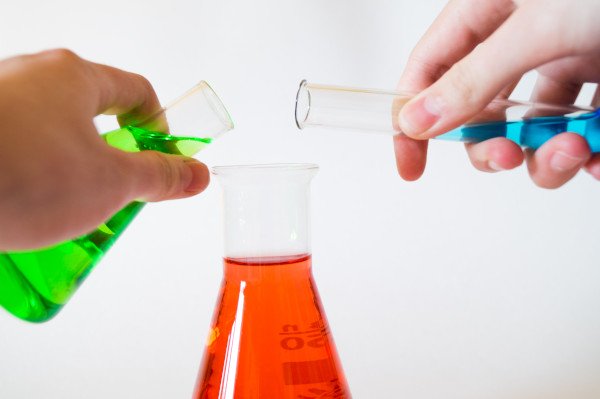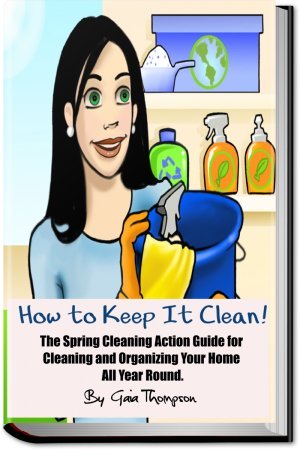- Are you new to housecleaning-tips.com: Start Here
- Claim your free copy of our Special Report: "How To Clean Your House: Advice From the Past"
Conjure Up Your Own Homemade Cleaning Products With These 3 Recipes

As a researcher the idea of making my own house cleaning products takes me back to those chemistry labs I suffered through in high school. The lighting bunsen burners and measuring chemicals in beakers are stained into my memories.
But now I get to go back just mixing different solutions together to make my own house cleaning products. This time though, I'm having more fun doing it. And - I don't have to worry about a failing grade.
In this article you will see why vinegar and baking soda tend to be the goto ingredients in many cleaning recipes. You will also get 3 homemade cleaning recipes from the ebook, 'How to Keep it Clean! An Action Guide for Cleaning and Organizing Your Home.'
Vinegar and Baking Soda
Two of my favorite ingredients to use in homemade cleaning products are white vinegar and baking soda. They are environmentally friendly and are great for cleaning.
Vinegar is a great and useful solvent that can be used to clean just about anything. It is great full strength or diluted a little bit.
No matter what you are trying to clean, you can do it with vinegar's power behind it. You can use vinegar diluted with water to clean your windows and mirrors. You can also use it to clean your countertops and bathroom surfaces. This will kill the bacteria and make your items shine.
Vinegar is also great full strength on your stainless steel products. You can also use it in your toilet bowls and on your floors. It will take away the bacteria and also get your floors to shine the way that you want them to.
White vinegar is a great natural disinfectant that removes mineral deposits and stains and does many other cleaning jobs. Here are a few...
- Vinegar and salt mixed together makes a great surface cleaner.
- Depending on how dirty your ceramic tile floor is, mix either a quarter or half cup of white vinegar into a gallon of warm water. This not only removes the dirt without having to scrub but there is no film left on the tiles.
- Apply warm vinegar to a cloth and squeeze the liquid onto stick-on hooks or bathtub no-slip decals to remove them.
- Mix a cup of vinegar into a gallon of warm water to remove grease and dull film from no-wax linoleum floors.
- Equal amounts of vinegar and water remove carpet stains, pet smells and clean ovens.
- To clean stone and brick floors, mix a cup of white vinegar into a gallon of warm water. Scrub the floor and then rinse it with clean water.
- To clean a dirty flower vase, add one or two tablespoons of vinegar and fill the base with warm water. Let this soak for half an hour and scrub with a soft cloth. Rinse and then dry and your flower vase will be clean and smell great.
- Into a spray bottle add one-quarter cup of vinegar and fill with water. Spray on windows or glass and use either paper towels or crumpled newspaper to dry and shine.
Baking soda is another great one to use in homemade cleaning products. This is a great product that you can use to clean your sinks. Just dump a little baking soda down the drain followed by a little bit of vinegar and you will have a bubbling cleaning product that will not only clean but sanitize.
You can use baking soda in the oven with a little bit of ammonia as well. Place a bowl filled with baking soda and ammonia in the oven and close the door. This will help to freshen it up and loosen the grime that is attached to the inside.
Some other ways you can use baking soda include...
- You can make a general cleaner by getting a quart of warm water and dissolving four tablespoons of baking soda into this.
- Make a paste using baking soda with a little water and rub on black heel marks to remove these from your floor.
- To deodorize and clean all your bathroom and kitchen surfaces, use baking soda on a clean, damp sponge.
- One half cup of baking soda added to the wash makes clothes and towels smell fresh and feel soft.
- On a damp cloth, sprinkle baking soda and then rub on your silverware to remove tarnish. Once you remove the tarnish, rinse and then dry.
There are so many other things that you can come up with. All you have to do is have a little bit of imagination and thought behind it. You can make just about any kind of cleaner that you need without going out and buying the harsh and overly priced ones from the store. You will have fun creating and coming up with your own homemade cleaning products.
This is just the tip of the iceberg.
Try These 3 Recipes to Start Making Your Own Homemade Cleaning Products
Pin for later?
1. General-Purpose Cleaner Spray Recipe
2 tablespoons vinegar1 teaspoon borax
Very hot water
1/4 cup liquid soap or detergent
10 to 15 drops essential oil (optional)
NOTE: It is very important that the ingredients be mixed exactly as shown below.
In a 16 ounce spray bottle, mix vinegar with borax. Fill bottle halfway with very hot water. Shake until borax is dissolved. Add liquid soap or detergent. You may add essential oil, such as lavender, eucalyptus, or rosemary. Choose something medicinal-smelling over sweet-smelling, so that it can stand up to the odor of vinegar.
2. Dishwashing Liquid
This formula will not create a lot of "suds," but it does the trick! Commercial soap makers use cheap industrial chemicals - mainly sodium laureth sulfate - to create the foaming action of your soap, but it does not mean it is any more effective at cleaning.
It really is a psychological marketing tactic - an illusion, if you think about it. Your dishwasher detergent does not foam, but your liquid dish soap does. The dishwasher soap is really much stronger, in order to be able to perform effectively. So is it important that sink version foams? In a word, "No."
It should be noted that some people develop sensitivity to the sodium laureth sulfate over time, because of over-exposure. It really is everywhere you look - hand soap, shampoo, dish soap, laundry detergent, bubble bath. If you have allergies and sensitivities, you may want to try the following formula:
1/4 cup soap flakes*2 cups hot water
1/4 cup glycerin
1/2 teaspoon lemon essential oil
Combine soap flakes and water and stir until the soap is dissolved. Cool until lukewarm.
Add the glycerin and the essential oil, and stir well. As the formula cools, it will begin to form into a gel. Using a fork or whisk, break up the gel, and pour into a squeeze bottle. (A funnel will be of great help.) Reuse an old dish soap or shampoo bottle for the container.
To use, simply squirt 3 into hot running water in the sink. Use with hot water. Do not use it in automatic dishwashers, because the agitation will make it foam up too much and cause the things that are supposed to spin in the dishwasher to get slowed down or stopped by the foam.
*If you cannot find packaged soap flakes, buy castile soap from a natural foods store or from the internet and use a box grater to turn it into flakes
3. Laundry Detergent
1 cup soap flakes (see note for dish soap)1/2 cup washing soda*, such as Arm & Hammer
1/2 cup Borax, such as 20 Mule Team Borax
Dissolve soap flakes with 3 pints of water over medium heat, until dissolved (about five minutes.) Stir in the washing soda and borax. When it begins to thicken, remove from heat. In a two-gallon bucket, put a quart of hot tap water, and then add the soap mixture. Mix well.
Fill the bucket to the top with cold water. Stir well, and pour into storage containers (use a funnel.) Since it can separate with sitting, shake the storage container well before using. Use 1/2 cup per load. (You may need less with a front-load/high efficiency machine.)
Washing soda is essentially sodium carbonate (in the same family as baking soda.) Since it has a pH of 11, it can damage surfaces, as well as eyes and skin, so take proper precautions. Do not use on aluminium or fibreglass. Be sure to read and follow all manufacturers' instructions.
Keep It Clean!
In the ebook, How to Keep it Clean! An Action Guide for Cleaning and Organizing Your Home, you will find over 40 recipes for homemade cleaning products.
You may also be interested in...
Get Amazing Results When You Learn the Baking Soda Uses for House Cleaning
Homemade Window Cleaner For Windows That Sparkle
7 Fun and Interesting House Cleaning Hacks To Get You Motivated
Home : Homemade Cleaning Products
